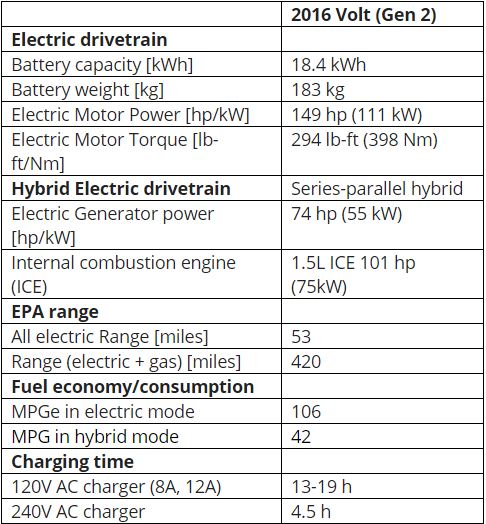2.4.3 Volt (Gen 2) – PHEV
Course subject(s)
Module 2. Introduction to Technology of EVs

Image: Chevrolet Volt (Source: Chevrolet, CC-BY-NC 3.0 license)
In this unit, we will look at the operation of the 2016 Chevrolet Volt (Gen 2) Plug-in Hybrid electric vehicle (PHEV). The key specifications of the PHEV are given in the table below:

Gen 2 Volt uses a large battery pack of 18.4kWh than the Gen 1 battery of 16.5kWh giving it a much higher electric range of 53 miles. What is interesting to note is that the Gen 2 battery pack, in spite of its larger energy capacity, has a lower weight than the Gen 1 battery pack. In both cases, the battery pack is T-shaped and placed in the bottom part of the vehicle. The Gen 2 Volt also has a much better fuel economy (energy efficiency) than the Gen 1 for both electric and hybrid mode which 106 MPGe and 42 MPG, respectively.
In the next set of images, let us look at the key components of the Gen 2 Volt.

Image: Chevrolet Volt propulsion system components showing the T-shaped battery pack at the bottom, the motor, the generator, ICE engine, power electronics and gearbox in the front (Source: Chevrolet, CC-BY-NC 3.0 license)

Image: Voltec hybrid electric drivetrain (Source: Chevrolet, CC-BY-NC 3.0 license)

Image: Chevrolet Volt Voltec propulsion system components showing the T-shaped battery pack at the back and the motor, the generator, ICE engine, power electronics and gearbox in the front (Source: Chevrolet, CC-BY-NC 3.0 license)

Image: Chevrolet Volt battery pack with energy capacity of 18.4 kWh. The pack is 5.5-foot-long T-shaped structure with glass-filled polyester structural composite with aluminium thermal radiation shield and steel. The pack is made of 192 prismatic cells and has a total weight of 183kg (Source: Chevrolet, CC-BY-NC 3.0 license)

Image: Chevrolet Volt Voltec drive unit showing the gear system and power split that is responsible for sharing the mechanical power between the engine, generator and motor (Source: Chevrolet, CC-BY-NC 3.0 license)

Image: Chevy Volt Voltec range extender system with a 1.5L DOHC I-4 engine with an output of 75 kW or 101 hp @ 5600 rpm (Source: Chevrolet, CC-BY-NC 3.0 license)

Image: Chevy Volt charging system showing a Type 1 inlet for the J1772 EV connector (Source: Chevrolet, CC-BY-NC 3.0 license)

Image: Chevy Volt fuel economy rating as provided by the EPA where the electric fuel economy, hybrid fuel economy, all electric range and total range of the EV are shown (Image source: EPA)

Electric Cars: Introduction by TU Delft OpenCourseWare is licensed under a Creative Commons Attribution-NonCommercial-ShareAlike 4.0 International License.
Based on a work at https://online-learning.tudelft.nl/courses/electric-cars-introduction/.



